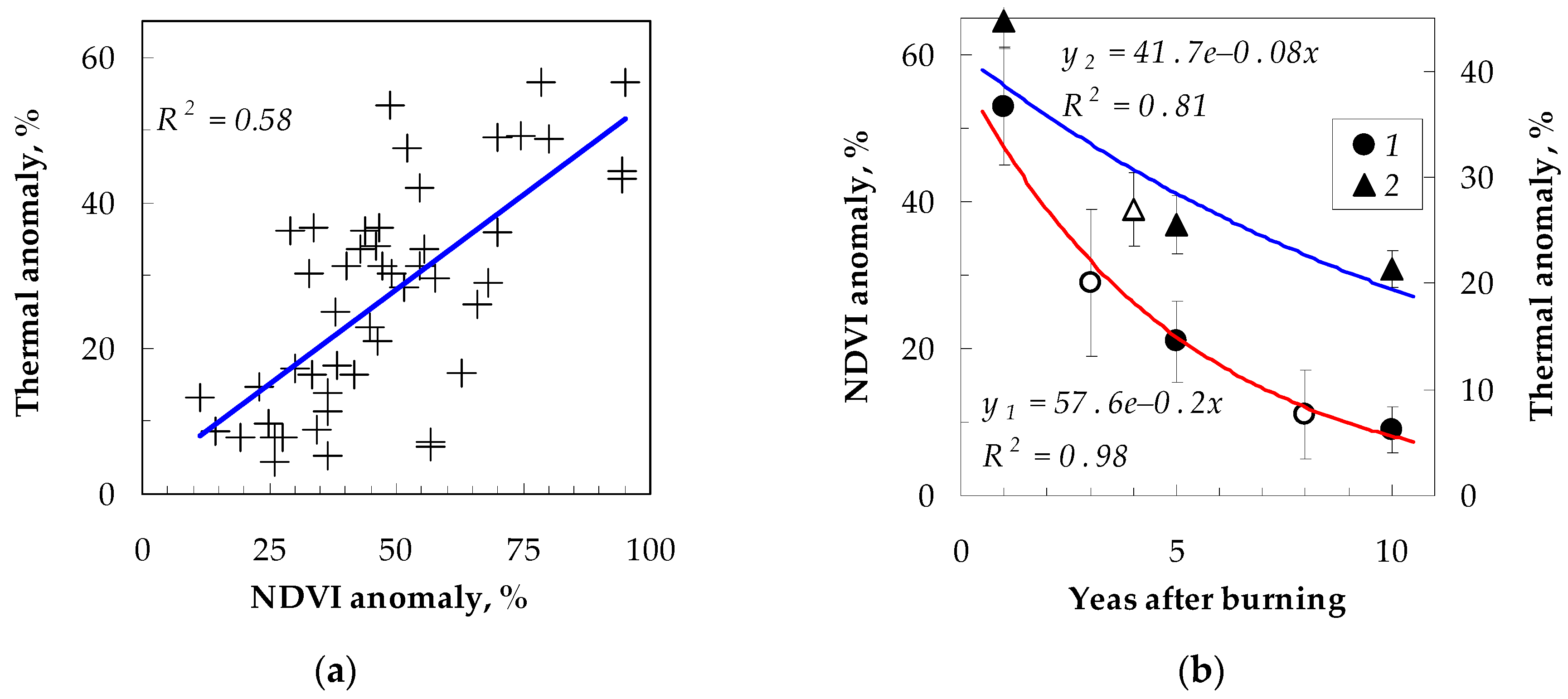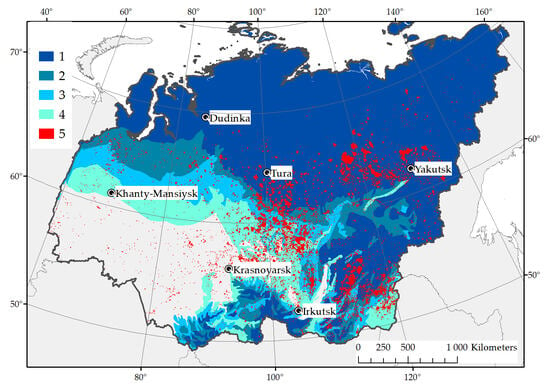Post-Fire Effect Modeling for the Permafrost Zone in Central Siberia on the Basis of Remote Sensing Data †
Abstract
:1. Introduction
2. Experiments
2.1. Study Area
2.2. Materials and Method
3. Results and Discussion
4. Conclusions
Author Contributions
Acknowledgments
Conflicts of Interest
Abbreviations
| MODIS | Moderate Resolution Imaging Spectroradiometer |
| NDVI | Normalized Difference Vegetation Index |
| RBA | Relative Burned Area |
| ETM | Enhanced Thematic Mapper |
| OLI | Operational Land Imager |
References
- Ivanova, G.A. Extreme fire-endangered seasons in forests of Evenkia. Siber. Ecolog. J. 1996, 3, 29–34. (In Russian) [Google Scholar]
- Sofronov, M.A.; Volokitina, A.V.; Kajimoto, T. Ecology of wildland fires and permafrost: Their interdependence in the northern part of Siberia. In Proceedings of the Eighth Symposium on the Joint Siberian Permafrost Studies between Japan and Russia in 1999, Tsukuba, Japan, 19–20 January 2000; pp. 211–218. [Google Scholar]
- Anisimov, O.A.; Sherstiukov, A.B. Evaluating the effect of environmental factors on permafrost in Russia. Kriosfera Zemli (Earth’s Cryosph) 2016, 2, 90–99. (In Russian) [Google Scholar]
- Ponomarev, E.I.; Ponomareva, T.V. The Effect of Postfire Temperature Anomalies on Seasonal Soil Thawing in the Permafrost Zone of Central Siberia Evaluated Using Remote Data. Contemp. Probl. Ecol. 2018, 11, 420–427. [Google Scholar] [CrossRef]
- Knorre, A.A.; Kirdyanov, A.V.; Prokushkin, A.S.; Krusic, P.J.; Buntgen, U. Tree ring-based reconstruction of the long-terminfluence of wildfires on permafrost active layer dynamics in Central Siberia. Sci. Total. Environ. 2019, 652, 314–319. [Google Scholar] [CrossRef] [PubMed]
- Brown, D.R.N.; Jorgenson, M.T.; Kielland, K.; Verbyla, D.L.; Prakash, A.; Koch, J.C. Landscape Effects of Wildfire on Permafrost Distribution in Interior Alaska Derived from Remote Sensing. Remote Sens. 2016, 8, 22. [Google Scholar] [CrossRef]
- Bezkorovaynaya, I.N.; Borisova, I.V.; Klimchenko, A.V.; Shabalina, O.M.; Zakharchenko, L.P.; Il’in, A.A.; Beskrovny, A.K. Influence of the pyrogenic factor on the biological activity of the soil under permafrost conditions (Central Evenkia). Vestnik KrasGAU 2017, 9, 181–189. (In Russian) [Google Scholar]
- Desyatkin, R.V.; Desyatkin, A.R. Temperature Regime of Solonetzic Meadow-Chernozemic Permafrost-Affected Soil in a Long-Term Cycle. Eurasian Soil Sci. 2017, 50, 1301–1310. [Google Scholar] [CrossRef]
- Brown, J.; Ferrians, O.J.; Heginbottom, J.A.; Melnikov, E.S. Circum-arctic map of permafrost and ground ice conditions, Ver. 2. 2002. Boulder, Colorado USA: National Snow and Ice Data Center. Digital media. Available online: https://nsidc.org/data/ggd318 (accessed on 4 February 2019).
- Ponomarev, E.I.; Shvetsov, E.G. Satellite survey of forest fires and GIS methods for data alignment. Issled. Zemli Kosmosa (Rem. Sens.) 2015, 1, 84–91. (in Russian). [Google Scholar] [CrossRef]
- Wan, Z.; Hook, S.; Hulley, G. MOD11A1 MODIS/Terra Land Surface Temperature/Emissivity Daily L3 Global 1km SIN Grid V006. NASA EOSDIS LP DAAC 2015. [Google Scholar] [CrossRef]
- Vermote, E.; Wolfe, R. MOD09GQ MODIS/Terra Surface Reflectance Daily L2G Global 250m SIN Grid V006. NASA EOSDIS LP DAAC 2015. [Google Scholar] [CrossRef]
- Arzhanov, M.M.; Eliseev, A.V.; Demchenko, P.F.; Mokhov, I.I. Simulation of dynamics of temperature and hydrological regime of near-surface permafrost using climatic data (reanalysis). Kriosfera Zemli (Earth Cryosphere) 2007, 11, 65–69. (In Russian) [Google Scholar]
- Vinogradov, Y.B.; Semenova, O.M.; Vinogradova, T.A. Hydrological modeling: Calculation of the dynamics of thermal energy in the soil profile. Kriosfera Zemli (Earth Cryosphere) 2015, 19, 11–21. (In Russian) [Google Scholar]
- Ponomarev, E.I.; Kharuk, V.I.; Ranson, J.K. Wildfires Dynamics in Siberian Larch Forests. Forests 2016, 7, 125. [Google Scholar] [CrossRef]
- de Groot, W.J.; Cantin, A.S.; Flannigan, M.D.; Soja, A.J.; Gowman, L.M.; Newbery, A. A comparison of Canadian and Russian boreal forest fire regimes. For. Ecol. Manag. 2013, 294, 23–34. [Google Scholar] [CrossRef]
- Kharuk, V.I.; Dvinskaya, M.L.; Ranson, K.J. Spatio-temporal dynamics of fires in the larch forests of the northern taiga of Central Siberia. Rus. J. Ecol. 2005, 5, 1–10. (In Russian) [Google Scholar]
- Abaimov, A.P.; Sofronov, M.A. The main trends of post-fire succession in near-tundra forests of central Siberia. In Fire in Ecosystems of Boreal Eurasia; Goldammer, J.G., Furyaev, V.V., Eds.; Kluwer Academic Publishers: Dordrecht, The Netherlands, 1996; pp. 372–386. [Google Scholar]
- Valendik, E.N.; Kisilyakhov, E.K.; Ryzhkova, V.A.; Ponomarev, E.I.; Danilova, I.V. Conflagration fires in taiga landscapes of Central Siberia. Geogr. Natur. Resour. 2014, 35, 41–47. [Google Scholar] [CrossRef]
- Desyatkin, R.V.; Desyatkin, A.R.; Fedorov, P.P. Temperature regime of taiga cryosoils of Central Yakutia. Kriosfera Zemli (Earth Cryosphere) 2012, 16, 70–78. (In Russian) [Google Scholar]
- Lebedeva, L.S.; Semenova, O.M.; Vinogradova, T.A. Calculation of the depth of seasonally melted layer in various landscapes of Kolyma water-balance station based on Gidrograf hydrological model. Kriosfera Zemli (Earth Cryosphere) 2015, 19, 35–44. (In Russian) [Google Scholar]
- Bartalev, S.A.; Stytsenko, F.V.; Egorov, V.A.; Loupian, E.A. Satellite-Based Assessment of Russian Forest Fire Mortality. Lesovedenie (For.) 2015, 2, 83–94. (In Russian) [Google Scholar]
- Vaganov, E.A.; Arbatskaya, M.K. The history of climate and fire frequency in the central part of Krasnoyarsk krai. 1. Climate conditions of a season and distribution of fires during a season. Siber. Ecol. J. 1996, 3, 9–18. (In Russian) [Google Scholar]
- Flannigan, M.; Stocks, B.; Turetsky, M.; Wotton, M. Impacts of climate change on fire activity and fire management in the circumboreal forest. Glob. Chang. Biol. 2009, 15, 49–560. [Google Scholar] [CrossRef]
- Kharuk, V.I.; Dvinskaya, M.L.; Petrov, I.A.; Im, S.T.; Ranson, K.J. Larch Forests of Middle Siberia: Long-Term Trends in Fire Return Intervals. Reg. Environ. Chang. 2016, 8, 2389–2397. [Google Scholar] [CrossRef] [PubMed]



| Time after Burning, Years | Anomalies of NDVI, % | Range of ΔT Maxima, °C | Anomalies of Temperature, % |
|---|---|---|---|
| 1 | 53.5 ± 10.7 | 6.5−7.2 | 40–50 |
| 5 | 21.0 ± 7.8 | 3.8−4.9 | 27–32 |
| 10 | 9.0 ± 5.0 | 3.4−4.6 | 15–20 |
© 2019 by the authors. Licensee MDPI, Basel, Switzerland. This article is an open access article distributed under the terms and conditions of the Creative Commons Attribution (CC BY) license (https://creativecommons.org/licenses/by/4.0/).
Share and Cite
Ponomarev, E.; Ponomareva, T.; Masyagina, O.; Shvetsov, E.; Ponomarev, O.; Krasnoshchekov, K.; Dergunov, A. Post-Fire Effect Modeling for the Permafrost Zone in Central Siberia on the Basis of Remote Sensing Data. Proceedings 2019, 18, 6. https://doi.org/10.3390/ECRS-3-06202
Ponomarev E, Ponomareva T, Masyagina O, Shvetsov E, Ponomarev O, Krasnoshchekov K, Dergunov A. Post-Fire Effect Modeling for the Permafrost Zone in Central Siberia on the Basis of Remote Sensing Data. Proceedings. 2019; 18(1):6. https://doi.org/10.3390/ECRS-3-06202
Chicago/Turabian StylePonomarev, Evgenii, Tatiana Ponomareva, Oxana Masyagina, Evgeny Shvetsov, Oleg Ponomarev, Konstantin Krasnoshchekov, and Alexander Dergunov. 2019. "Post-Fire Effect Modeling for the Permafrost Zone in Central Siberia on the Basis of Remote Sensing Data" Proceedings 18, no. 1: 6. https://doi.org/10.3390/ECRS-3-06202
APA StylePonomarev, E., Ponomareva, T., Masyagina, O., Shvetsov, E., Ponomarev, O., Krasnoshchekov, K., & Dergunov, A. (2019). Post-Fire Effect Modeling for the Permafrost Zone in Central Siberia on the Basis of Remote Sensing Data. Proceedings, 18(1), 6. https://doi.org/10.3390/ECRS-3-06202








